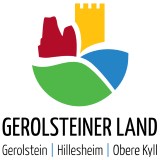Sidinger Drees
Gerolstein
This was or is probably the most famous Drees – this is what the Eifeler calls its mineral springs – in the Gerolsteiner Land, even though mineral water no longer bubbles here today. The Kyll valley has one of its narrowest places here, the Kyll itself is only a few meters wide. Since the Devonian limestone and dolomite rocks are heavily fissured and karstized underground, there were and still are sufficient transport and ascent routes for the mineral water.
The source and its history
So it is not for nothing that the Sidinger Drees is such a special place. During previous excavations, a stone axe was found here. Thus the Sidinger Drees would be a source area used and revered since at least the Celtic period, because such important utensils as a stone axe were sacrificed then only to the mighty source gods. Over the centuries the Romans and “Romanized” Celts settled the Kylltal. An important manor house was the Villa Sarabodis on the opposite side of Kyll with bathhouse and hot water heating. The Roman or Romanized Celts had carefully built their villa there. It was right across from a bubbling healing spring, the Sidinger Drees. The Roman rulers used the Drees as a source of healing, bathing and drinking. They paid homage to the spring gods and nymphs by throwing coins into the wells, perhaps out of hope or gratitude for the healing of sore wounds and straining intestines. During excavations, hundreds of Roman coins were found, mostly from the time of Emperor Maximinius (235 - 238 AD), as well as votive gurus and other cult objects.
In 1723, the water of the Sidinger Dreis was praised because it “removes the constipation of the liver, bile and intestines, and strengthens the stomach and all intestines”. Promptly Count Franz Georg von Manderscheid-Blankenheim had the spring recaptured and the “highly acclaimed” water in jugs filled with his coat of arms. Through his Cologne branch he distributed the water as far as Holland. The Sidinger Drees is rightly regarded as the source of the local mineral water industry. The Sidinger Drees fell into the possession of the town of Gerolstein in 1890, but was now finally dried up. Several attempts were made later to find and grasp the source, but in vain. Today, a pavement with fountains, modelled on the Roman model, adorns the former Sidinger Drees. When stopping on site, you should be aware that the most important geological and geographical units of the Gerolstein Land are covered here in a very small space: Dolomites and limestone of the Middle Devon, Early Quaternary Eifel basalt, Gerolstein mineral water and the young breakthrough valley of the Kyll.
The source and its subsoil
The mineral water of the Sidinger Dreis was a calcium-magnesium-hydrogencarbonate acidifier. Calcium and magnesium came from the carbonate rocks, and the carbon dioxide in the water – the carbonic acid, as the saying goes – was partly of volcanic origin. In ancient writings it is reported that in 1874 there was a very strong gushing of the spring, and at the same time the smell of sulphur in the crater of the Papenkaule, which lies only about 1 km to the northeast. Looking north over the Kyll and the railway line, one looks at the head of the Sarresdorf lava flow, which erupted from that area at the end of the last ice age and flowed into the Kyll valley.









